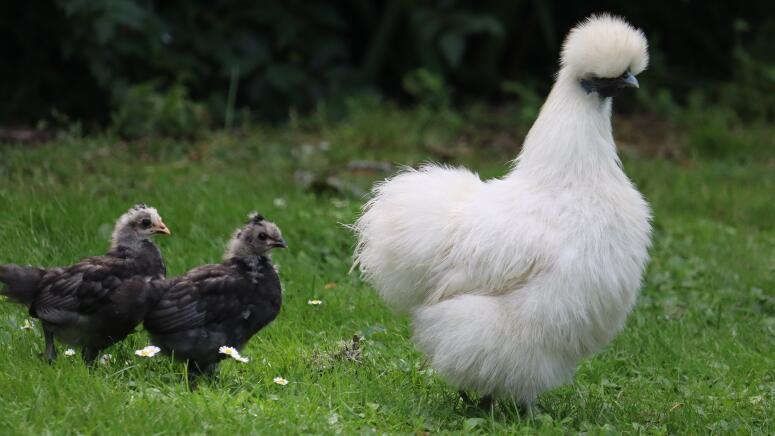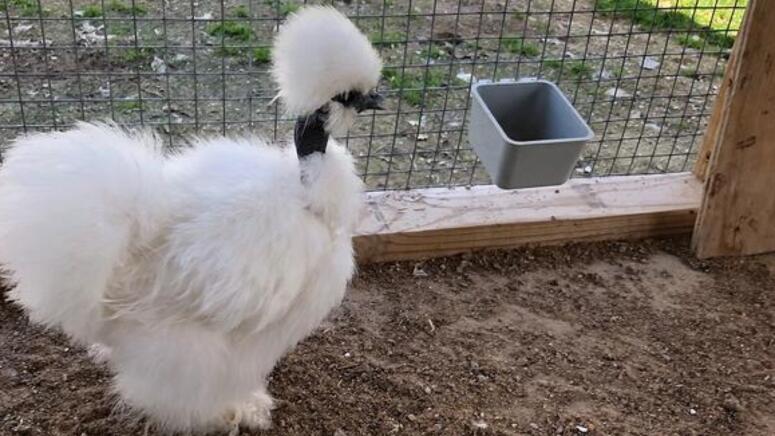Posted by Sherry Klaus, Tue, Feb 11, 2020; updated Wed, June 22, 2023
I came across and fell in love with Silkie chickens after breeding and showing chickens for a few years. I found them so irresistible that I hastily acquired some eggs from a breeder in Tennessee, among other places, as soon as they caught my eye.
I have been hatching, breeding and showing Silkie chickens ever since. Due to the Silkie chickens’ adorable appearance and sweet disposition, they are a very popular breed among famous people and backyard enthusiasts alike.

Silkie Characteristics
Silkie chickens are a bantam breed that is believed to have originated in ancient China. Bantam chickens are smaller than normal-size chickens. Silkie chickens also have beautiful, soft, fluffy feathers which are unlike those of other hard-feathered poultry.
Although some say these feathers resemble fur, they do not serve as a protectant for the bird. Some Silkies' feathers cover their feet like the one seen below.
Other awesome Silkie traits include their black or blueish skin, feathered feet, and five toes instead of the usual four. Silkie chickens can sometimes be born with vaulted skulls and may be bearded. Vaulted skulls are skulls that have an opening at the top. This is similar to human babies’ soft spots.
Human babies’ soft spots will grow together and become harder. This is sometimes true for Silkie chickens as well. Vaulted skulls were sought after long ago (and sometimes still are today), as they give the appearance of a higher crest. Their crests are a cute tuft of feathers on top of their heads, and their beards are the elongated feathers below the beak.

Silkie Varieties
There are so many wonderful options when adding Silkies to your flock. Silkie chickens come in solid colors such as White, Buff, Black, Blue and Self-Blue. The patterned varieties include Paint, Splash, Partridge and Gray.
I have recently come to love the Naked Neck Silkie. This Silkie is a cross between a Silkie Bantam and a Turken (commonly known as a “naked neck” chicken).

Why Raise Silkies?
While Silkies seem like fragile birds, they are hearty chickens that can be an asset to your flock. They often grow broody and can incubate other chickens’ eggs; however, they will need to be watched more closely than your other chickens if you are free-ranging since they cannot fly to escape from predators.
I let mine free-range while I am doing chores and return them to their enclosures when I am not able to keep an eye on them.
American Paint Silkie
I’ve grown particularly attached to the American Paint Silkie variety of the breed. The American Poultry Association recently recognized the American Paint Silkie in 2018. You can identify this breed by the black splotches on their otherwise white feathers.
I am grateful to have been a part of their recognition show in 2017. It was very exciting to see this beautiful variety of Silkie get the recognition it deserved.

Fun Facts About Silkie Chickens
- Silkie chickens make great incubators and mothers
- Silkie chickens do not have to roost, but some will
- They lay between 80 and 120 eggs a year
- They have black or blueish skin and bones
- Silkie chickens will co-parent chicks
- They have five toes
- The breed is thought to have originated in China
Interested in learning more about this and other fabulous poultry breeds? Download our complete Chicken Breed chart here.

Featured Products

